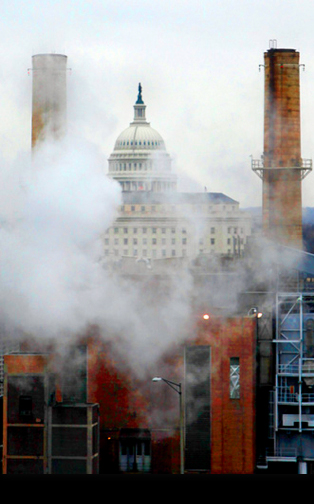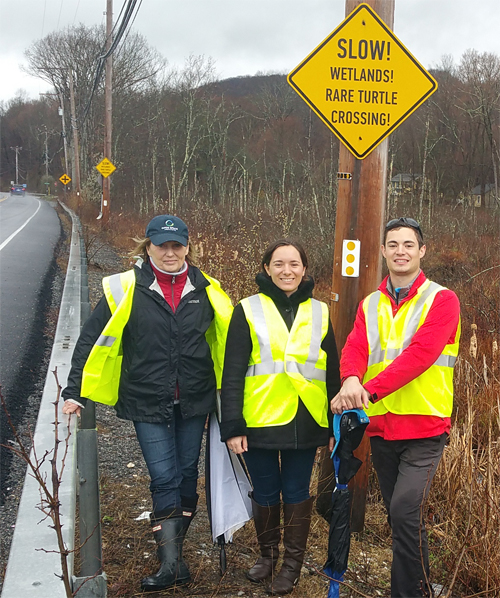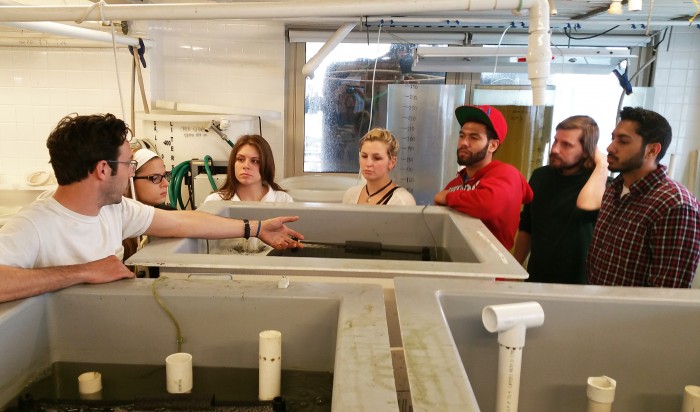Why aren’t the natural resources of the nation’s capital granted the same status as its monuments and museums?

Capitol Power Plant by Peter Muller. Used with permission. http://www.petemullerphotography.com/
Instead, the Potomac River is still the “national disgrace” President Lyndon Johnson declared it to be in 1965. The eight-mile Anacostia River, a contaminated tributary to the Potomac in the heart of the city, is unsafe for swimming and fishing. And the Capitol Power Plant is a smoky, primitive electric generating facility run on a coal and diesel mixture in the shadow of Capitol Hill.
The Potomac
The Potomac, once the shad fishing grounds of prominent fisherman George Washington, received a grade of “D” in a 2010 evaluation by the University of Maryland. In 2012, it topped the list of the nation’s most endangered rivers, published annually by the environmental organization American Rivers:
The Potomac is the “nation’s river,” rich in culture and history and the lifeblood of our nation’s capital. The river provides drinking water to more than five million people and offers abundant opportunities for recreation. However, the Potomac is threatened by agricultural and urban pollution . . . [which] threatens drinking water supplies, kills fish, and poses a health risk to people who swim, fish, and boat on the river.
There are consumption advisories for Potomac fish in Washington, Virginia and Maryland:
http://doh.dc.gov/doh/cwp/view,a,1374,q,584650,dohNav_GID,1837.asp
http://www.vdh.state.va.us/HHControl/fishingadvisories.asp
http://www.mde.state.md.us/CitizensInfoCenter/Health/fish_advisories/index.asp
The Anacostia
Last January, the Natural Resources Defense Council described the Anacostia River as:
[A] poster child for America’s tragically neglected, abused urban waterways . . . severely polluted by sediment, nutrients, pathogens, toxins and trash.
The Anacostia, which flows through the poorest section of the city, is the subject of multiple citizen initiatives, such as the Anacosta Watershed Society, the Earth Conservation Corps, and the Anacostia Watershed Restoration Partnership. But implementation of a 1987 watershed agreement failed, in part because of a profound lack of federal interest.
Now the Anacostia, part of EPA’s Urban Waters Federal Partnership, is in desperate need of more than a meagerly funded federal program where the competitive vying for government dollars is as pressing a concern as the mission of the program itself.
The Capitol Power Plant
An August 9 New York Times article, Cut Emissions? Congress Itself Keeps Burning a Dirtier Fuel, called the Capitol Power Plant:
[T]he largest single source of carbon emissions in the nation’s capital and a concrete example of the government’s inability to green its own turf.
And reported:
. . . [O]ne of the plant’s main boilers had exceeded the 10 ton-per-year limit for nitrogen oxides, which can cause severe breathing difficulties, by more than 20 tons per year since 2000. . . Some critics say officials at the power plant are purposely choosing to burn dirtier fuel, as a political statement.
The plant, a political football kicked around the Congress for years, was fully fueled by coal until 2007, at the insistence of legislators from coal states. Today, with its diesel/coal mix, community members are worried that air quality in the vicinity of the facility is a danger to the health of them and their children. Congress has taken no corrective action or allocated funding to improve the plant.
A Special Designation for the Washington Environment
Depending on the issue, Washington is a city that sits upon the shoulders or beneath the heel of Congress. Held high, the Smithsonian is the jewel of the city and the nation, at great expense maintaining its status as the most celebrated scientific, cultural and historical institution on the planet. Down low, ground into the oily, chemical-laden firmament, are the natural resources of the capital, which Congress has chosen to neglect.
Washington is also a city of monuments and museums, as befits its place in history, and on the world stage. Congress routinely funds, by the billions, a long list of amenities and institutions, ranging from the National Mall to the White House to the Air and Space Museum, that welcome and educate our citizens and international visitors, and foster national pride.
Sometimes the funding is creative. When the Washington Monument was in need of repair after a 5.8 magnitude earthquake in August 2012, Congress appropriated $7.5 million on the condition it be matched by donations; it was. The Holocaust Memorial Museum, National Gallery of Art, Presidio Trust, and Smithsonian Institution are congressionally chartered organizations (CCOs) that use their federal designation, and federal funding, to leverage private donations, draft influential Boards of Governors, and elevate their institutional status.
The Smithsonian is an excellent example. In addition to its 20 museums, galleries and zoo, it boasts impressive environmental and conservation credential across the globe, such as the carbon mapping of Panama and the gene flow of Indian Tigers. It receives 70% of its funding from the federal budget. Private benefactors provide the remainder. Why not direct some of its best talent to the nation’s front yard? Or why not simply create a CCO with the dedicated purpose of restoring and preserving the Washington environment, as if it too were a national museum or monument?
It is time for new federal thinking, and new federal money. Decades of failure plague the air and water of Washington DC. The natural resources of the nation’s capital deserve the same care as any of its standing institutions. They too should be a national example, not a national disgrace.
«« »»
 About photographer Peter Muller: “Since 2005, I have worked to document the individual consequences of war, poverty and social unrest. Through a combination of photography, text, audio and video recordings, I aim to illustrate broader issues through individual stories. I strive to create images and material that demand consideration for the lives of those depicted.” More about Peter at his beautiful website: http://www.petemullerphotography.com/
About photographer Peter Muller: “Since 2005, I have worked to document the individual consequences of war, poverty and social unrest. Through a combination of photography, text, audio and video recordings, I aim to illustrate broader issues through individual stories. I strive to create images and material that demand consideration for the lives of those depicted.” More about Peter at his beautiful website: http://www.petemullerphotography.com/









